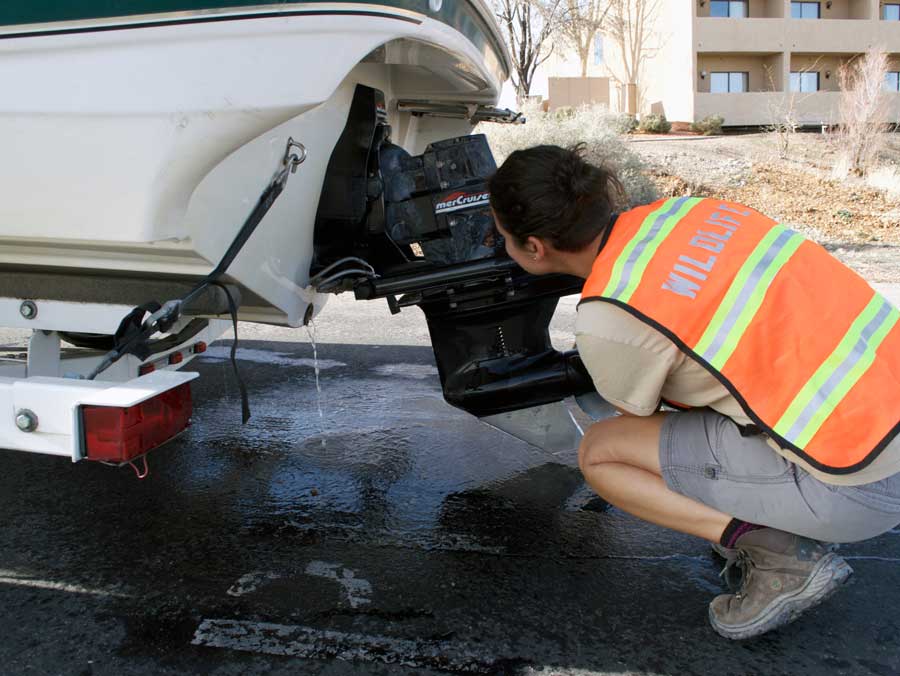Nearly 300K boat inspections completed in 2019 to prevent invasive quagga mussels from spreading
SALT LAKE CITY — Utah Division of Wildlife Resources and State Parks personnel were busy during the 2019 boating season, completing almost 300,000 boat inspections in an effort to prevent invasive quagga mussels from spreading from Lake Powell and other infested waters to other Utah waterbodies.
DWR and State Parks completed a total of 295,238 boat inspections across Utah, a 22% increase from the previous year’s 241,557 inspections. They also decontaminated 8,683 boats, a 13% increase from the 7,684 boats that required decontamination during the 2018 boating season.
Lake Powell is currently the only waterbody in Utah with quagga mussels, and saw a majority of this year’s efforts. DWR and National Park Service staff conducted 99,571 inspections at Lake Powell, a 54% increase from the previous year’s 64,482 inspections at the popular boating destination.
The busiest weekend for boating inspections and decontaimations fell on the weekend after the Fourth of July. A total of 9,730 inspections were done statewide on July 6-7.
“This was an extremely busy and exhausting year for our crews,” Nathan Owens, the DWR Aquatic Invasive Species Coordinator, said. “However, despite that, our crews at Lake Powell were able to increase the numbers of inspections and decontaminations that were performed on departing boats, while simultaneously dealing with the huge increase in the number of boats that were retrieved from the water with mussels onboard.”
DWR law enforcement officers were also kept busy enforcing the mandatory inspection stations and administrative checkpoints. As of Sept. 23, conservation officers had stopped a total of 9,192 boaters in 2019, and had issued citations for 438 violations.
“Overall, boaters have been really supportive of our inspection and monitoring efforts,” Scott Dalebout, the DWR statewide operations lieutenant, said. “We really appreciate their cooperation and continued efforts to help us in preventing the spread of this invasive species.”
While the busiest part of the boating season typically ends by the first of November, DWR personnel will still be performing boat inspections year-round at Lake Powell and boaters are still required to comply with inspections.
“If you happen to be taking your boat off Lake Powell at a time when our staff isn’t available for an inspection, we are still asking boaters to clean, drain and dry their boat,” Dalebout said. “It is very important to continue to be vigilant throughout all times of the year.”
DWR also plans to increase efforts for next year to continue the containment of aquatic invasive species at Lake Powell.
“We are currently operating above capacity and our folks are exhausted,” Dalebout said. “We are trying to change some things to become more efficient and garner more resources for these efforts.”
Steps for decontaminating a boat
To help prevent the spread of quagga mussels, after you are done boating at Lake Powell or anywhere out of state, you must do the following to decontaminate your boat if you choose not to have a professional hot water decontamination done:
- Clean: Boaters should wipe all mud, plant materials and other debris from their boat. In particular, make sure to inspect the anchor and sea strainer.
- Drain: Boaters are required to pull all drain plugs and leave them out during transport and storage after boating on Lake Powell. All water should be completely drained from ballast tanks, bilges and live wells. Boaters with outboard or inboard/outboard engines should drop the lower unit to drain those areas, as well. Also, flush and inspect the cooling intake or water system on the boat.
- Dry: All boats with ballast tanks, inboard engines or inboard/outboard engines retain water at all times. As a result, boats must remain out of the water for 30 days after a visit to Lake Powell before you can launch anywhere else in Utah, regardless of the time of year.

















